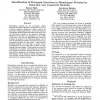500 search results - page 48 / 100 » The PIR-International Protein Sequence Database |
NAR
2011
12 years 10 months ago
2011
The primary purpose of PHOSIDA (http://www .phosida.com) is to manage posttranslational modification sites of various species ranging from bacteria to human. Since its last report...
ISMB
1998
13 years 9 months ago
1998
Homologousproteins do not necessarily exhibit identical biochemicalfunction. Despitethis fact, local or global sequence similarity is widely used as an indication of functional id...
BMCBI
2008
13 years 7 months ago
2008
Background: Non-homology based methods such as phylogenetic profiles are effective for predicting functional relationships between proteins with no considerable sequence or struct...
BMCBI
2006
13 years 7 months ago
2006
Background: This article addresses the problem of interoperation of heterogeneous bioinformatics databases. Results: We introduce BioWarehouse, an open source toolkit for construc...
ICASSP
2007
IEEE
14 years 1 months ago
2007
IEEE
There are currently a large number of ‘‘orphan’’ G-protein-coupled receptors (GPCRs) whose endogenous ligands (peptide hormones) are unknown. Identification of these pepti...

